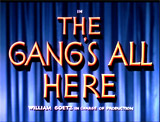
|
The Gang's All Here (1943)
In director Busby Berkeley's musical (his sole Fox
film, his first Technicolor film, and the first film that he both
directed and choreographed); its simple plot of soldier boy-meets-chorus
girl was overshadowed by complex and extravagant production numbers:
|
The Opening Sequence: "Brazil"
|

|

|

|
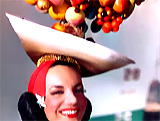
|
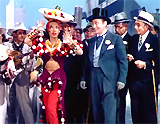
|

|
- one of the most famous and amazing of Berkeley's
production numbers was the six-minute long number that occurred
in the film's opening; it began with a male singer Aloysio de Oliveira
(his floating face was surrounded by black) crooning the Latin
song "Brazil (Aquarela Do Brasil)"; as the camera pulled
back, it was shown that he was on a docked ship at port, the S.S.
Brazil; the next panning shot focused on the unloading of passengers
who were disembarking down a gangplank, while a dockworker pushed
a wagon-cart of burlap bags of SUGAR, and other roped bundles of
merchandise (exports from Brazil) were lowered to the dock (including
a large bundle of fruit) - the fruit was revealed to be, in a quick
and invisible cut during a downward pan, on the head of Dorita
(Carmen Miranda, the "Brazilian Bombshell"); the belly-dancer
made her entrance wearing the fruit-bowl shaped hat, a red-and-white
pom-pom outfit with a bare midriff, while also singing "Brazil" (backed
by a mariachi band)
- a marching band entered from off-stage, playing "Hail to the
Chief"
- a limousine pulled up next to the band, with a top-hatted, formally-clad
city official coming up to Dorita and asking: "Got any coffee
on ya?"; she smiled and replied: "Such a very handsome
fellow. So you come to welcome me?"; he responded by offering
her the keys to the city: "In the place of Fiorello, I present
you with a key"
[Note: Fiorello referred to Fiorello LaGuardia, NYC's mayor at the
time]
- another camera pull back revealed the entire scene was being performed
on a Broadway nightclub stage in NYC, the Club New Yorker
- Dorita began to sing a second song: "You Discover You're In
New York"; during the second chorus of the song, Dorita walked
off stage and into the nightclub
- seven, stylishly black-clad chorines seated at tables in the club
joined her (each of them sang one of two lines of the song), before
the camera returned to Dorita who finished the song
- meanwhile, the other chorus members took the stage and danced with
her during the number's finale - Dorita disappeared behind a red
curtain as the number concluded; the stage host joked about how the
coffee Dorita had bestowed upon him would make him rich ("Now
I can retire"), then greeted her back on stage to take a bow:
"Well, there's your Good Neighbor Policy. C'mon honey, let's
good neighbor it! There we are!"
- the second major Berkeley production number was
about 23 minutes into the film - a 7-minute long, bizarre and erotic
musical number known as: "The Lady in the Tutti-Frutti Hat"
- it began with an organ grinder, his monkey, and lots of fabric
banana trees with more monkeys
- dozens of bare-legged and bare-footed showgirls (with yellow turbans,
black crop tops, and ruffled yellow miniskirts) lounged on a tropical
South Seas island stage set, with their legs half-splayed open (filmed
from a high-angle top view); they rushed to the shore to wave and
greet Dorita, as she arrived on a banana cart pulled by two live
gold-painted oxen
- surrounded by the island girls, Dorita sang "The Lady in a
Tutti Frutti Hat", and was soon joined by the chorus girls who
surrounded her with a ring of bananas (that she played like a circular
xylophone)
- the chorus girls formed a chorus line, as they carried (and waved)
surreal, oversized, erect six-foot tall bananas (major phallic symbols
made of papier mache)
- the bananas were arranged in two rows, and moved into various geometric
patterns
- seven of the girls laid down in a star formation with wide-open
legs, holding inflatable, oversized strawberries - as a circle of
bananas tipped forward and came together above them (an unabashed
enactment of sex)
- an undulating, waving motion was again made with the bananas, before
much of the opening of the sequence was seen in reverse
- the number concluded with about a dozen organ grinders (and monkeys),
and the sight of an enormous fan of bananas coming out of the top
of Dorita's headdress 30 feet into the air, and two rows of giant
strawberries on either side of her
- the final balletic production number: "The
Polka Dot Polka" began with a group of dancing children dressed
in polka-dotted clothes
- the song's basic lyrics were sung by showgirl Edith (Alice Faye): "The
polka dance is gone, but the polka dot lives on"
- chorus girls played with neon-lit hula hoops, first appearing as
floating, disembodied floating heads against a blue curtained backdrop;
and in the air, they slowly rotated the gigantic, neon polka-dot
hoops, and then were seen with giant, green and pink cut-out circles
or discs (a disorienting sequence later showed them moving in reverse)
- a surrealistic kaleidoscopic camera view (seen from a top angle)
topped off the finale with many abstract shapes and patterns
- the disembodied heads of all the principal actors zoomed up and
appeared one at a time in the middle of a polka dot, singing the
movie's signature love song: "A Journey to a Star"
|

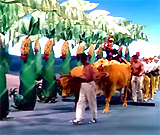
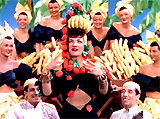


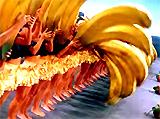


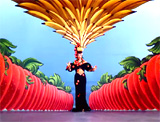
"The Lady in the Tutti Frutti Hat"
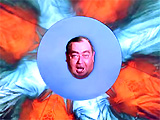
Finale: "A Journey to a Star"
|











